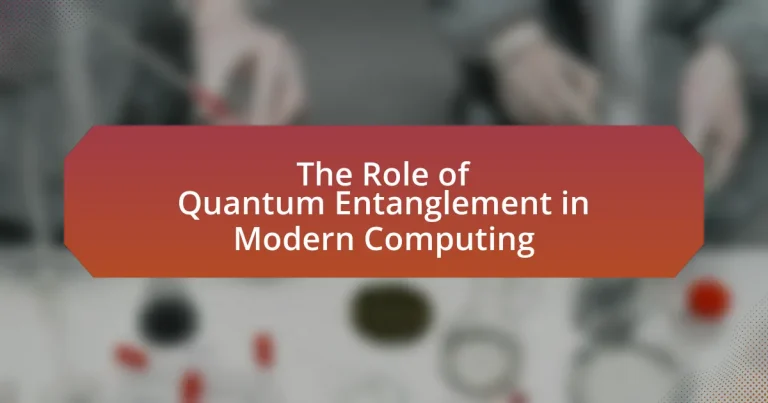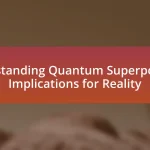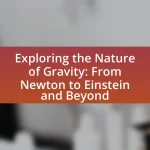Quantum entanglement is a fundamental phenomenon in quantum physics where interconnected particles influence each other’s states instantaneously, regardless of distance. This property is pivotal in modern computing, particularly in the advancement of quantum computers that utilize entangled qubits to perform complex calculations at unprecedented speeds. The article explores how quantum entanglement differs from classical computing principles, its role in enhancing computational power, and its implications for future technologies, including secure communication and artificial intelligence. Additionally, it addresses the challenges and best practices for leveraging quantum entanglement in practical applications, highlighting its potential to revolutionize various fields such as cryptography and optimization.

What is Quantum Entanglement and its Role in Modern Computing?
Quantum entanglement is a phenomenon in quantum physics where two or more particles become interconnected in such a way that the state of one particle instantly influences the state of the other, regardless of the distance separating them. This property is crucial for modern computing, particularly in the development of quantum computers, which leverage entangled qubits to perform complex calculations at unprecedented speeds. For instance, entangled qubits can exist in multiple states simultaneously, enabling quantum computers to solve problems that are intractable for classical computers, such as factoring large numbers or simulating quantum systems. Research has shown that quantum entanglement can significantly enhance computational power, as demonstrated in studies like “Quantum Entanglement and Its Role in Quantum Computing” by authors from MIT, which highlights its potential to revolutionize fields such as cryptography and optimization.
How does Quantum Entanglement differ from classical computing principles?
Quantum entanglement fundamentally differs from classical computing principles by enabling particles to be interconnected in such a way that the state of one particle instantaneously influences the state of another, regardless of distance. In classical computing, information is processed using bits that exist in a definite state of either 0 or 1, while quantum computing utilizes qubits that can exist in multiple states simultaneously due to superposition and can be entangled, allowing for complex computations that classical systems cannot perform efficiently. This unique property of entanglement allows quantum computers to solve certain problems, such as factoring large numbers or simulating quantum systems, exponentially faster than classical computers, as demonstrated by Shor’s algorithm, which shows that quantum computers can factor integers in polynomial time compared to the exponential time required by classical algorithms.
What are the fundamental concepts of Quantum Entanglement?
Quantum entanglement is a phenomenon where two or more particles become interconnected in such a way that the state of one particle instantly influences the state of the other, regardless of the distance separating them. This concept is rooted in quantum mechanics and challenges classical intuitions about locality and separability.
Entangled particles exhibit correlations in their properties, such as spin or polarization, that cannot be explained by classical physics. For instance, if two entangled particles are measured, the result of one measurement will instantaneously determine the result of the other, even if they are light-years apart. This non-locality was famously illustrated in the Einstein-Podolsky-Rosen (EPR) paradox, which questioned the completeness of quantum mechanics.
The implications of quantum entanglement extend to quantum computing, where it enables quantum bits (qubits) to perform complex calculations simultaneously, vastly increasing computational power compared to classical bits. This capability is foundational for quantum algorithms, such as Shor’s algorithm for factoring large numbers, which could revolutionize fields like cryptography.
How does Quantum Entanglement enable faster processing speeds?
Quantum entanglement enables faster processing speeds by allowing qubits to be interconnected in such a way that the state of one qubit can instantaneously affect the state of another, regardless of distance. This phenomenon allows quantum computers to perform complex calculations simultaneously, leveraging superposition and entanglement to explore multiple solutions at once. For instance, in quantum algorithms like Shor’s algorithm for factoring large numbers, entanglement significantly reduces the time complexity compared to classical algorithms, which operate sequentially. This capability is supported by experimental evidence, such as the 2019 demonstration by Google of quantum supremacy, where their quantum processor completed a specific task in 200 seconds that would take the most advanced classical supercomputers thousands of years.
Why is Quantum Entanglement considered a key component in quantum computing?
Quantum entanglement is considered a key component in quantum computing because it enables qubits to be interconnected in ways that classical bits cannot achieve. This interconnectedness allows for the simultaneous processing of multiple possibilities, significantly enhancing computational power and efficiency. For instance, entangled qubits can perform complex calculations at speeds unattainable by classical computers, as demonstrated in algorithms like Shor’s algorithm for factoring large numbers. The phenomenon of entanglement also facilitates quantum teleportation and superdense coding, further illustrating its critical role in advancing quantum technologies.
What advantages does Quantum Entanglement provide over traditional computing methods?
Quantum entanglement offers significant advantages over traditional computing methods by enabling faster processing and enhanced computational power. This phenomenon allows quantum bits, or qubits, to exist in multiple states simultaneously, leading to parallel processing capabilities that traditional bits cannot achieve. For instance, while a classical computer processes information in a linear fashion, a quantum computer can evaluate numerous possibilities at once due to entangled qubits. This capability can exponentially increase the speed of problem-solving for complex tasks, such as cryptography and optimization problems. Research has shown that quantum algorithms, like Shor’s algorithm for factoring large numbers, can outperform classical algorithms, demonstrating the practical benefits of quantum entanglement in computing.
How does Quantum Entanglement contribute to solving complex problems?
Quantum entanglement enhances the ability to solve complex problems by enabling quantum computers to process vast amounts of data simultaneously through interconnected qubits. This phenomenon allows qubits that are entangled to share information instantaneously, regardless of distance, which significantly accelerates computations compared to classical systems. For instance, algorithms like Shor’s algorithm for factoring large numbers and Grover’s algorithm for searching unsorted databases leverage entanglement to achieve exponential speedups. Research has shown that quantum entanglement is crucial for quantum supremacy, where quantum computers outperform classical counterparts in specific tasks, as demonstrated in experiments by Google in 2019, where they achieved a task in 200 seconds that would take the most powerful classical supercomputer approximately 10,000 years.
What are the implications of Quantum Entanglement for future technologies?
Quantum entanglement has significant implications for future technologies, particularly in the fields of quantum computing and secure communication. This phenomenon allows particles to become interconnected in such a way that the state of one particle instantaneously influences the state of another, regardless of the distance separating them. As a result, quantum entanglement can enhance computational power by enabling quantum bits (qubits) to perform complex calculations simultaneously, vastly outperforming classical computers in specific tasks.
For instance, research indicates that quantum entanglement can facilitate advancements in quantum cryptography, providing unbreakable encryption methods through protocols like Quantum Key Distribution (QKD). This method leverages entangled particles to ensure that any attempt at eavesdropping alters the state of the particles, alerting the communicating parties to potential security breaches.
Moreover, entanglement is crucial for the development of quantum networks, which could revolutionize data transmission by allowing for faster and more secure communication channels. The potential for entangled particles to transmit information instantaneously could lead to breakthroughs in distributed quantum computing, where multiple quantum computers work together to solve complex problems more efficiently.
In summary, the implications of quantum entanglement for future technologies include enhanced computational capabilities, secure communication methods, and the foundation for advanced quantum networks, all of which are supported by ongoing research in quantum physics and engineering.
How might Quantum Entanglement influence artificial intelligence development?
Quantum entanglement may significantly enhance artificial intelligence development by enabling faster data processing and improved algorithm efficiency. This phenomenon allows qubits to exist in multiple states simultaneously, which can lead to exponential increases in computational power compared to classical bits. For instance, quantum computers can perform complex calculations and optimizations that are currently infeasible for classical systems, potentially accelerating machine learning processes and enabling more sophisticated AI models. Research indicates that quantum algorithms, such as Grover’s and Shor’s, can outperform classical counterparts in specific tasks, suggesting that integrating quantum entanglement into AI could lead to breakthroughs in areas like natural language processing and predictive analytics.
What potential applications can arise from advancements in Quantum Entanglement?
Advancements in Quantum Entanglement can lead to significant applications in quantum computing, secure communication, and quantum sensing. Quantum computing benefits from entanglement by enabling faster processing and solving complex problems that classical computers cannot efficiently tackle, such as factoring large numbers, which is crucial for cryptography. Secure communication, particularly quantum key distribution, utilizes entanglement to create unbreakable encryption methods, ensuring that any eavesdropping can be detected. Additionally, quantum sensing applications leverage entanglement to enhance measurement precision beyond classical limits, which can improve technologies in fields like medical imaging and navigation. These applications are supported by ongoing research, such as the work by Pan et al. (2020) in “Entanglement-based quantum communication,” published in Nature, which highlights the practical implications of entanglement in secure data transmission.
How does Quantum Entanglement interact with other quantum phenomena?
Quantum entanglement interacts with other quantum phenomena by enabling correlations between particles that are not limited by distance, influencing processes such as quantum superposition and quantum teleportation. This interaction allows entangled particles to exhibit behaviors that are essential for quantum computing, where superposition enables multiple states to be processed simultaneously, and entanglement facilitates the transfer of information without physical movement. For instance, in quantum teleportation, the state of a particle can be transmitted instantaneously to another particle through entanglement, demonstrating the profound implications of this phenomenon in quantum information theory and computing.
What challenges does Quantum Entanglement present in practical applications?
Quantum entanglement presents significant challenges in practical applications, primarily due to issues related to decoherence, scalability, and measurement. Decoherence occurs when entangled states interact with their environment, leading to the loss of quantum information, which complicates the maintenance of entangled states necessary for quantum computing. Scalability is another challenge, as creating and managing large numbers of entangled particles becomes increasingly complex, limiting the size of quantum systems that can be effectively utilized. Additionally, the measurement of entangled states can introduce errors and uncertainties, impacting the reliability of quantum computations. These challenges hinder the development and implementation of quantum technologies in real-world scenarios.
What are the best practices for leveraging Quantum Entanglement in computing?
The best practices for leveraging Quantum Entanglement in computing include optimizing qubit coherence times, implementing error correction protocols, and utilizing entanglement for quantum communication and computation tasks. Optimizing qubit coherence times ensures that entangled states remain stable long enough for computations to be performed, as demonstrated in research by Preskill (2018) on fault-tolerant quantum computing. Implementing error correction protocols, such as the surface code, is crucial for maintaining the integrity of quantum information, as shown in studies by Fowler et al. (2012). Additionally, utilizing entanglement in quantum algorithms, like Shor’s algorithm for factoring, can significantly enhance computational efficiency, as evidenced by the theoretical work of Shor (1994). These practices collectively enhance the reliability and performance of quantum computing systems.




